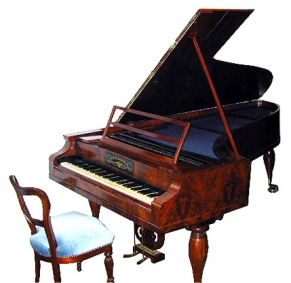Stein's successors
Johann Baptist Streicher, Vienna 1838, collection Rudolf Haase/Switherland
The typical Viennese romantic grand is often furnished luxuriously with selected fine woods. Another speciality was a thinly planed plate of wood above the strings resting on small wooden blocks. Usually considered a dust cover this plate acted as a kind of second resonance board. Another sort of dust cover was a cloth filling in a wooden frame slightly equalising the sound spectrum. These dust covers often were removed later.
music sample:
(excerpt) Johannes Brahms, Walzer op. 39
played by Rolf Junghanns and Fritz Neumeyer
Instrument: Johann Baptist Streicher, 1864, Bad Krozingen
Maria Anna (usually called Nanette) Stein (1769-1833), daughter of Johann Andreas Stein, was a disciple of her father as well as a renowned pianist. Mozart who met her during his visit in Augsburg 1777 reported home with amusement about her still childish way of playing but also about her father's pride of his talented daughter. In 1794 Nanette Stein married the pianist Johann Andreas Streicher, a close friend of Schiller's, and moved to Vienna. She ran the piano workshop together with her younger brother Matthäus Andreas Stein; later her husband took more tasks after her brother opened an own workshop in 1802. The Streicher firm directed by her son Johann Baptist (1796-1871; active from 1833) and her grandson Emil (1836-1916) was active till 1896.
The pianos of the Viennese Stein/Streicher workshop were famed for clarity and delicacy of sound but were less voluminous than their main local competitors like Walter or later Graf and werre considered favourable for more intimate music making in salons than for public presentations in bigger concert halls.
Animation of the action
The inventive spirit of Johann Andreas Steins lived on in his descendants. Under impression of the first English pianos arriving in Vienna a special "Anglo-German" action with elements of both actions. Another speciliality were downbeating action which were supposed to stay more constant in tuning since the hammers did not lift the strings off the bar; these instruments also omitted the gap between wrestplank and resonance board which could be increased in dimensionand kept the construction more stable under tension.
But these advantages also had flaws: The key mechanism was situated directly above the pins and had to be lifted off for tuning. The hammers also did not return to thir initial position after striking the strings and had to be returned by pulling springs and counterweights. what made the touch heavier.
© Greifenberger Institut für Musikinstrumentenkunde | info@greifenberger-institut.de




